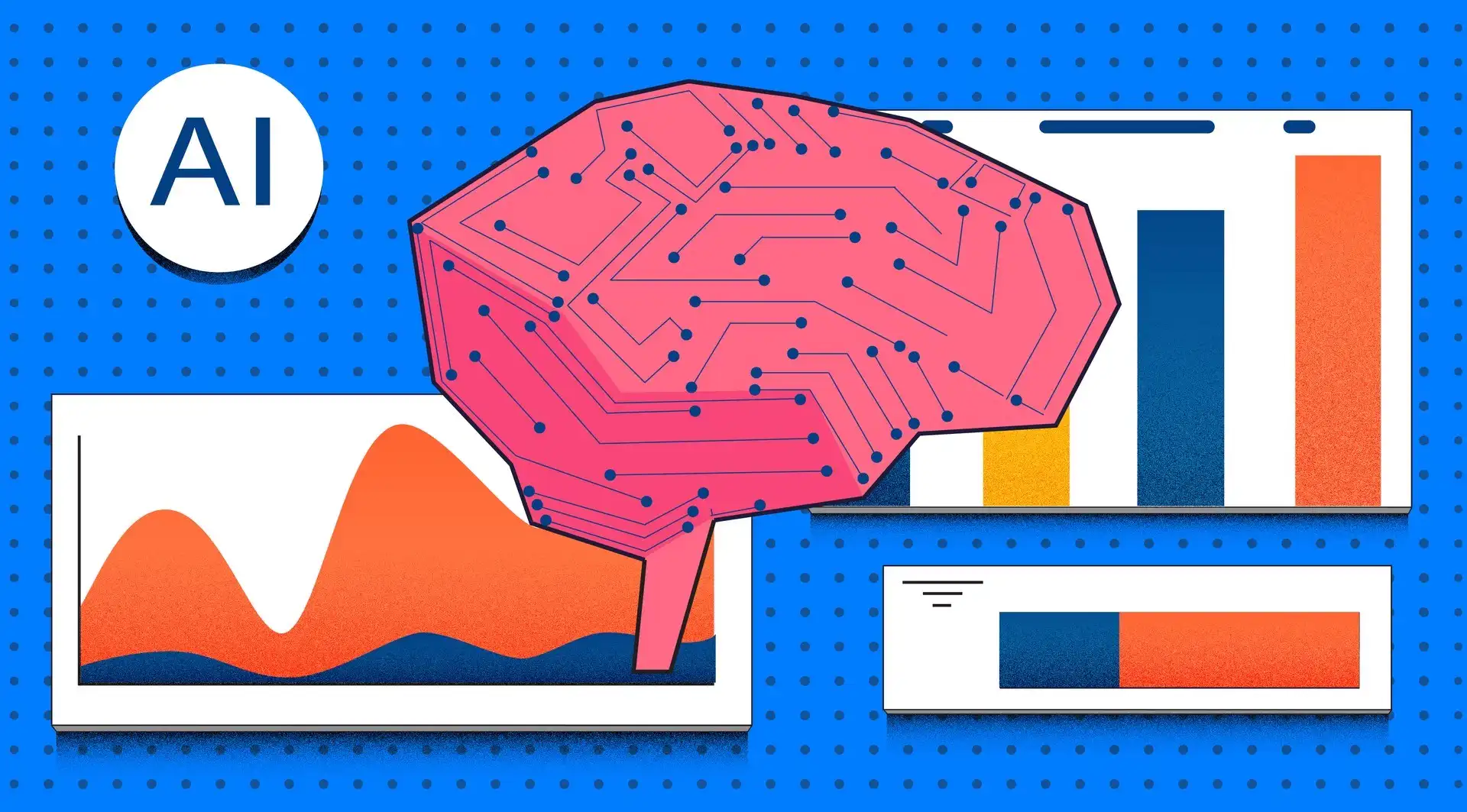Artificial intelligence is rapidly transforming our world, and the potential uses and impacts of this technology are endless. Opinions about AI may vary. Elon Musk has even said, "AI is a fundamental risk to the existence of human civilization." In contrast, Mark Zuckerberg said once that "AI is the new electricity, and we [Meta] want to be the ones wiring it up."
Interesting that billionaires have such different attitudes toward a technology that is likely to completely revolutionize their businesses in the 2020s. As an AI enthusiast, I am rather amazed than terrified by the power and potential of this technology. However, I understand that this is a topic that causes discussions.
From revolutionizing healthcare and transportation to optimizing production and decision-making, the uses for AI are seemingly endless. In this article, I’ll explore some new, surprising, and fascinating statistics about AI that highlight the ways in which this technology is shaping our world and the direction it is headed in the coming years. From the economic impact of AI to the ways in which it is being used across a variety of industries, these data provide a glimpse into the future of AI.
Whether you are an AI enthusiast, want to implement it in your work or simply curious about the technology, I encourage you to read on and discover some of the most interesting and surprising statistics about AI.
Let's start!
What is Artificial Intelligence? A definition of AI
Artificial intelligence (AI) refers to the ability of a computer or machine to perform tasks that would normally require human-like intelligence, such as recognizing patterns, learning from experience, making decisions, and problem-solving.
AI technologies include machine learning, natural language processing, and robotics, among others. These technologies are being used in a wide range of applications, including self-driving cars, personal assistants, medical diagnosis, and financial trading, to name just a few.
Current state of AI
The current state of AI is that it has made significant progress in recent years and is being used in a wide range of applications. There are different types of AI, ranging from narrow or weak AI, which is designed to perform a specific task, to strong or general AI, which has the ability to perform any intellectual task that a human can.
Narrow AI is currently being used in many practical applications, such as self-driving cars, virtual personal assistants, medical diagnosis, and financial trading. These systems are able to perform specific tasks with a high degree of accuracy and have the potential to significantly improve efficiency and productivity in a variety of industries.
However, strong or general AI, which would have the ability to perform any intellectual task that a human can, is still the stuff of science fiction and is not yet a reality. Research in this area is ongoing and it is unclear when or if we will see the development of general AI.
These changes are sure to gain even more rapid traction. Currently, there are many indications that Marc Benioff's words "AI will probably transform the world far more in the next 20 years than the internet has in the last 20 years." will prove to be true.

Key Artificial intelligence facts and statistics
1. AI has the potential to create economic growth of up to $13 trillion by 2030 (Stanford University)
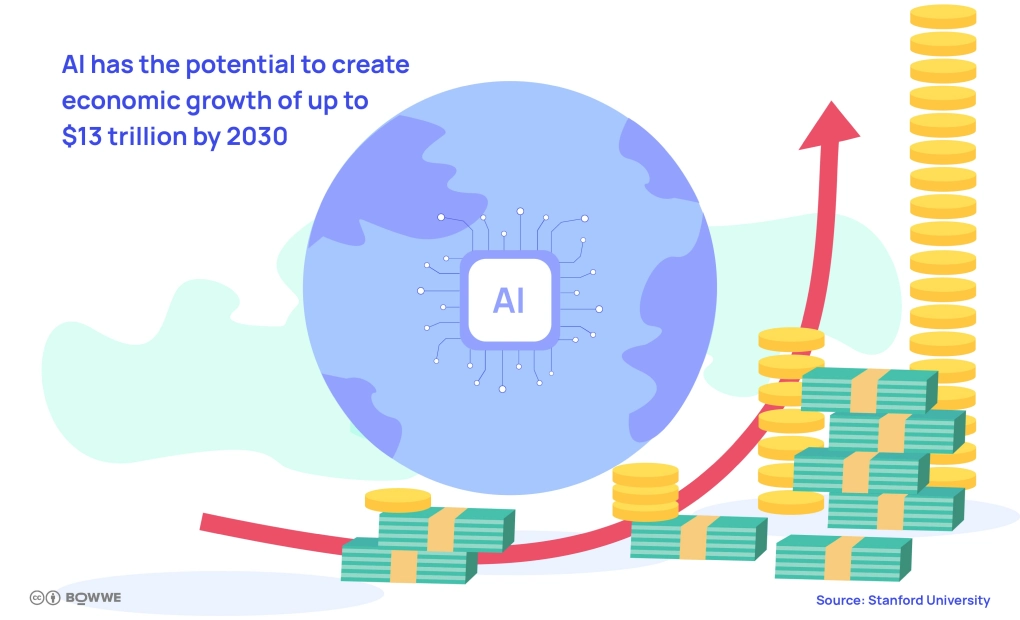
The potential for AI to create economic growth of up to $13 trillion by 2030 is based on the idea that AI can improve productivity and efficiency in various industries, leading to increased output and economic growth.
Stanford's study also suggests that AI has the potential to create new markets and industries, further driving economic growth. For example, the development and deployment of self-driving cars and drones could lead to the creation of new transportation services and related industries.
Additionally, the study suggests that AI can be used to automate certain tasks and processes, freeing up human workers to focus on more complex and value-added activities. This could lead to increased productivity and economic growth.
Overall, the potential for AI to drive economic growth is significant, and it is likely that the impact of AI on the economy will continue to grow in the coming years as the technology becomes more widespread and sophisticated.
2. Deployment of AI could increase productivity by 40% and drive a 20% increase in profitability by 2035 (Accenture)
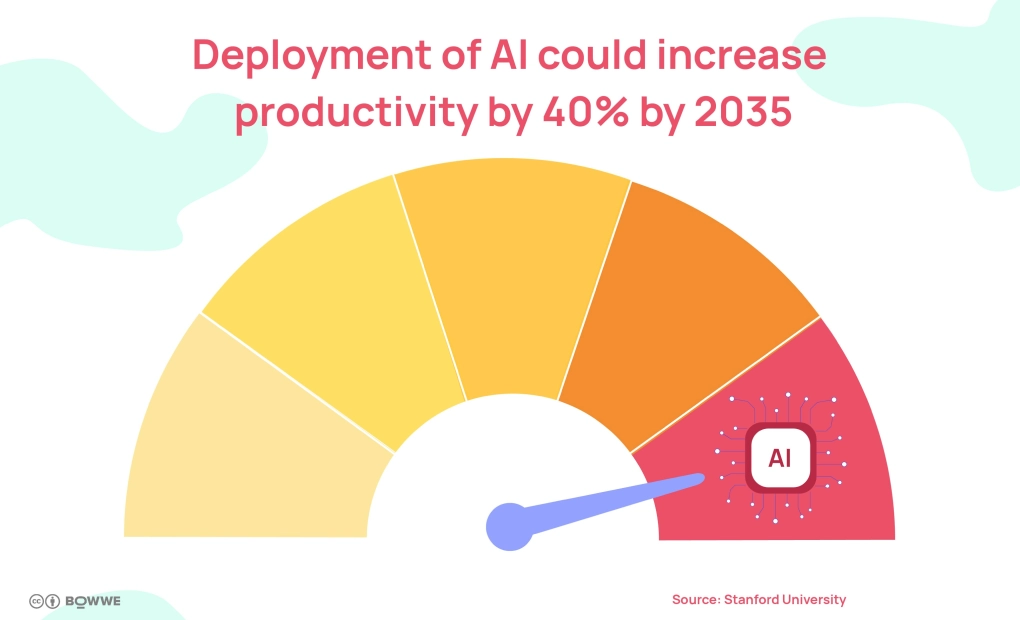
This is because AI can automate certain tasks and processes, freeing up human workers to focus on more complex and value-added activities.
In addition, AI can improve decision-making and assist with data analysis, leading to more efficient and effective business operations. AI can also be used to optimize production and supply chain management, further increasing efficiency and productivity.
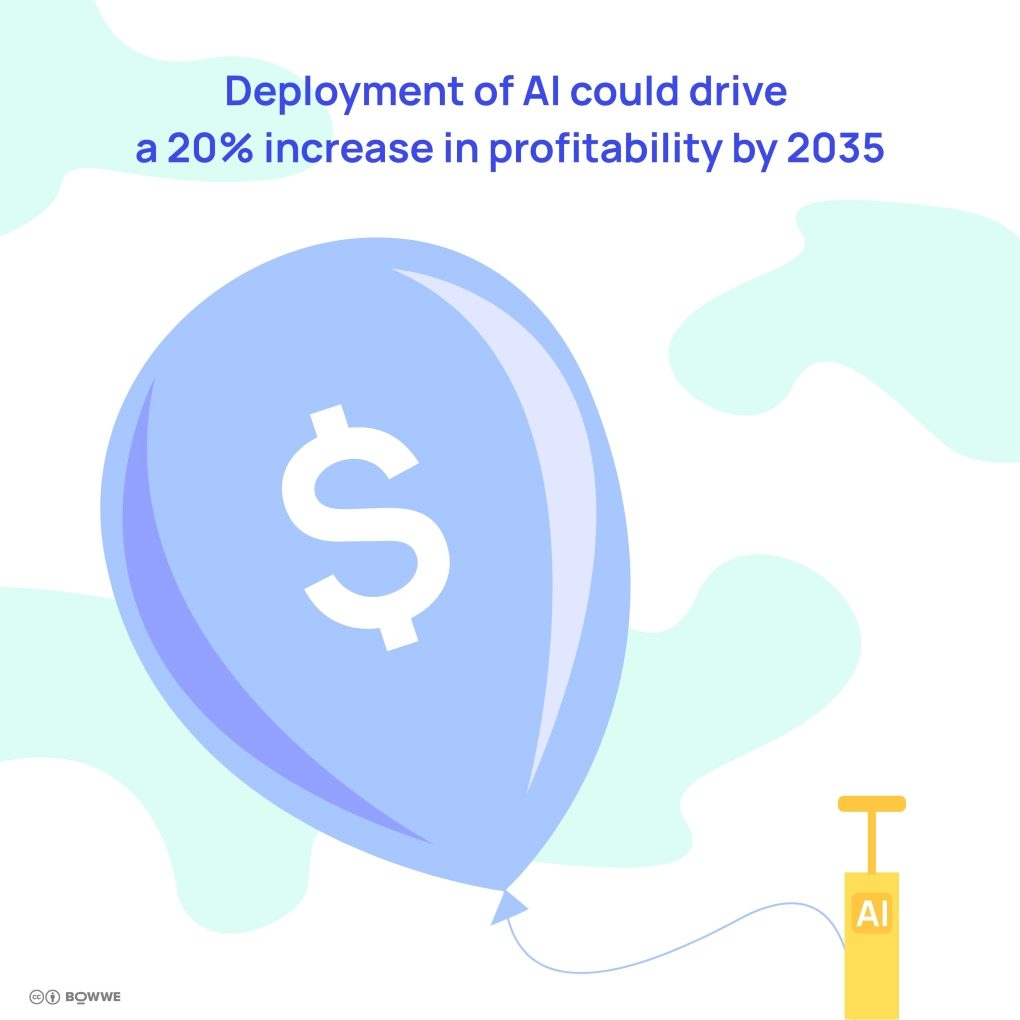
AI has great potential to drive productivity and profitability improvements is significant, and it is likely that the adoption of AI by businesses and organizations will continue to increase in the coming years as the technology becomes more advanced and widely available.
3. The global AI market is expected to reach $190.61 billion by 2025 (MarketsandMarkets)
Why is the global AI market expected to grow so huge? Reason is a number of factors including the increasing AI-adoption, the growing availability of data for training AI systems, and advances in hardware and software technology that make it easier to develop and deploy AI applications.
In addition, the increasing availability of cloud-based AI services is also driving market growth, as it makes it easier for businesses to access and utilize AI capabilities without having to invest in expensive infrastructure.
The growth of the AI market is being driven by the increasing recognition of the potential benefits of AI, including improved efficiency and productivity, the ability to automate certain tasks and processes, and even the possibility to create new products and services.
4. 72% of Americans believe that AI will be mostly responsible for creating new job opportunities in the future (Pew Research Center)
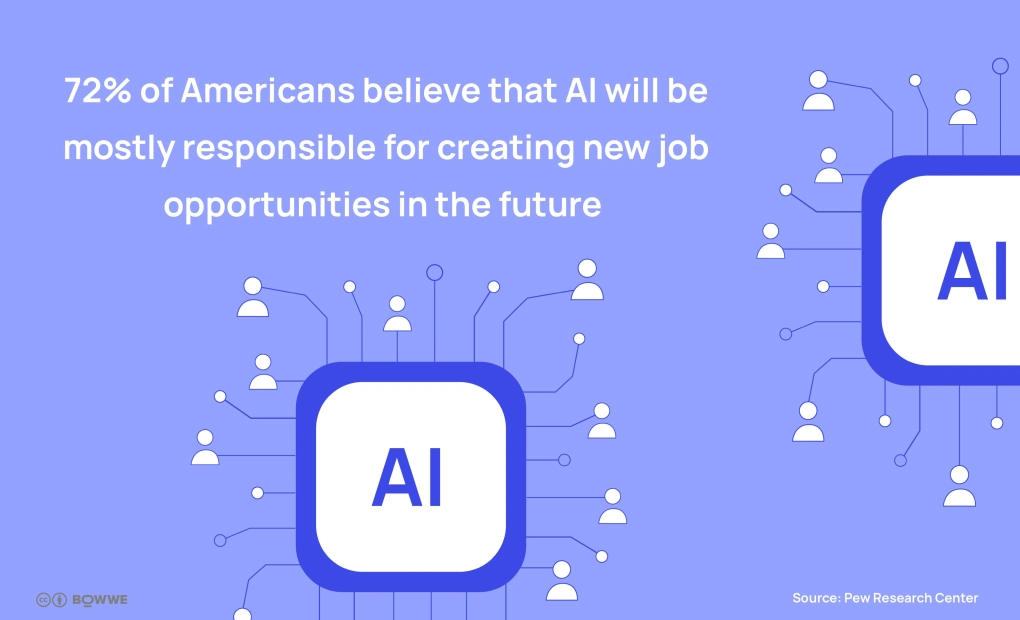
This belief is based on the idea that AI has the potential to automate certain tasks and processes, freeing up human workers to focus on more complex and value-added activities.
While it is true that AI will probably automate certain jobs, it is also likely to create new job opportunities in industries where AI is being adopted. For example, the deployment of self-driving cars could lead to the creation of new transportation services and related industries, while the use of AI in healthcare could lead to the development of new medical treatments and technologies.
The potential impact of AI on employment is often a topic of debate, and some people argue that AI will lead to widespread job displacement. But, it is worth noting that the adoption of new technologies has always had an impact on employment, and in the past, these changes have often led to the creation of new industries and job opportunities. While it is important to be mindful of the potential impacts of AI on employment, it is also important to recognize the potential benefits that AI can bring, including increased efficiency, productivity, and the development of new products and services.
5. AI will create around 9 million jobs by 2025 (Accenture)
The study by Accenture, titled "The Growth Multiplier: How Artificial Intelligence is Boosting Business Growth and Productivity," was published in 2020. The study estimates that AI will create around 9 million jobs by 2025. The basis of their research is a survey of over 1,200 C-level executives and other senior leaders from large companies across 12 countries and 19 industries. The study aims to understand the current and future impact of AI on businesses and the economy. It looks at the ways in which companies are using AI, the benefits they are seeing from it, and the challenges they are facing. The study also includes a macroeconomic analysis to estimate the potential impact of AI on job creation.
Elon Musk, the CEO of SpaceX and Tesla, has been a vocal critic of AI and has expressed concerns about the potential negative impacts of the technology on employment. In an interview with CNBC, Musk said that AI has the potential to "reduce the cost of certain jobs, particularly manual labor and repetitive tasks, to zero," leading to widespread job displacement.
Musk has also warned that the development of AI could lead to a "dystopian future" in which a small number of people control the technology and use it to dominate the rest of society. He has called for greater regulation and oversight of AI development to ensure that the technology is used for the benefit of humanity. His comments highlight the potential risks and challenges associated with the development of AI and the importance of ensuring that the technology is developed and used in a responsible and ethical manner.
However, there are also examples of AI being used to augment human work rather than replace it. For example, AI is being used in customer service to handle routine inquiries, freeing up human agents to handle more complex issues. In healthcare, AI is being used to assist doctors with diagnosis and treatment planning, rather than replacing them. These cases prove that AI may improve our work.
In general, while it is important to be mindful of the potential impacts of AI on employment, it is also important to recognize the potential benefits that AI can bring, including increased efficiency, productivity, and the development of new products and services.
Get started
No coding experience required.
6. In 2018, AI was responsible for creating nearly 300,000 new jobs in China (Harvard Business Review)
According to a report, China created nearly 300,000 new jobs with AI in 2018, making it a leader in the adoption and deployment of AI technology. The new jobs were created across a range of industries, including manufacturing, retail, and healthcare.
The success of China in creating new jobs with AI challenges the dominant narrative that AI will primarily lead to job loss and suggests that the impact of AI on employment may be more complex and varied than often assumed.
China's success in creating new jobs with AI highlights the potential benefits of the technology and the importance of proactive approaches to addressing the potential impacts of AI on employment. By embracing AI and adopting proactive strategies, countries and businesses can ensure that the benefits of the technology are shared broadly and that the potential risks are managed effectively.
7. Number of AI-related patent applications has increased dramatically in recent years, with China leading the way in terms of volume (World Intellectual Property Organization)
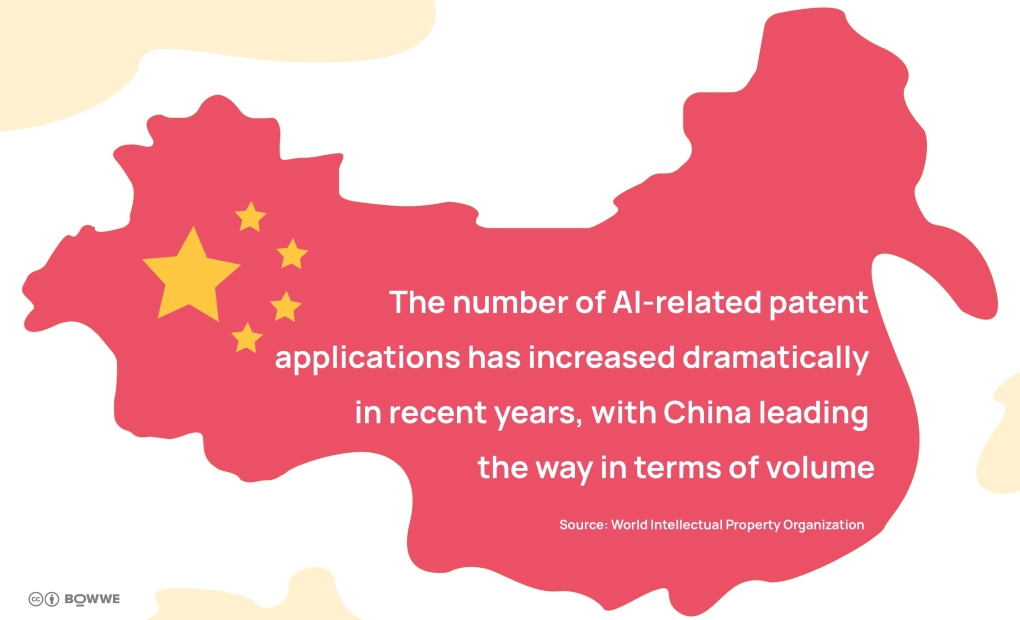
China filed over 50% of the world's AI-related patent applications in 2017, followed by the United States and Japan.
This trend reflects China's increasing dominance in the field of AI and its efforts to become a leader in the development and deployment of the technology. The large number of AI-related patent applications in China is a testament to the country's investment in research and development and its ambition to become a global leader in AI.
The rapid increase in AI-related patent applications highlights the growing importance of AI in a variety of industries and the fierce competition among countries and businesses to develop and deploy the technology. It also raises questions about the potential risks and challenges associated with the development of AI, including the potential for the technology to be used in ways that are harmful to society.
8. AI could contribute an additional $15.7 trillion to the global economy by 2030 (PwC)
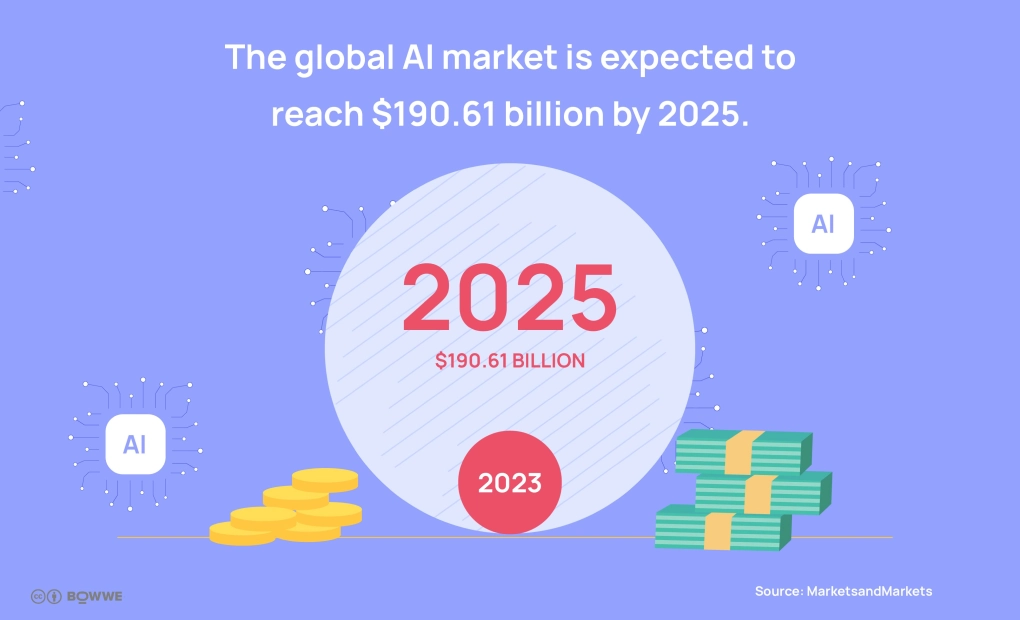
This impressive figure is based on the idea that AI has the potential to improve productivity and efficiency in various industries, leading to increased output and economic growth.
It is likely that the deployment of AI will continue to increase in the coming years, with the technology being used in a wide range of industries and applications. In 2030, it is very possible that AI will be used to automate a variety of tasks and processes, freeing up human workers to focus on more complex and value-added activities.
Artificial Intelligence. Frequently Asked Questions and Interesting Facts
How to measure the power of AI?
There are many different factors that can contribute to the "advancedness" of an AI system. Some of the factors that are often used to measure that include:
- The ability of the system to perform tasks that are typically associated with human intelligence, such as understanding and generating natural language, recognizing and interpreting images and video, and learning and adapting to new environments and situations.
- The complexity and sophistication of the algorithms and techniques used by the system.
- The amount and quality of data that the system has been trained on.
- The performance of the system on various benchmarks and tasks.
What is the most advanced AI?
Some examples of AI systems that are often considered to be particularly advanced include:
- Google's DeepMind, which has achieved impressive results in a variety of areas, including natural language processing, image recognition, and game playing.
- OpenAI's GPT-3, which is one of the largest and most powerful language models currently available and is capable of generating human-like text.
- IBM's Watson, which has been used to tackle a variety of tasks, including natural language processing, image recognition, and decision-making.
- The AlphaGo system developed by DeepMind, which was able to defeat a human champion at the complex board game Go.
Ultimately, the "most advanced" AI system is likely to depend on the specific criteria and metrics being used to evaluate the system.
What is the most advanced AI chatbot?
As with the most advanced "general AI softwate," it's hard to point to the best one for AI chatbots, too. Some examples of AI chatbots that are often considered to be particularly advanced include:
- Google's Duplex, which is able to hold natural conversations with humans and can be used to make phone calls on behalf of users to schedule appointments or make reservations.
- OpenAI's GPT-3
- IBM's Watson, which has been used to develop a variety of chatbots that are able to understand and respond to natural language input.
- Microsoft's Xiaoice, which is a social chatbot that is able to hold conversations with users on a variety of topics.
Is artificial intelligence dangerous?
One potential concern about AI is that it could become superintelligent, surpassing human intelligence and potentially posing a threat to humanity. However, this is still a matter of speculation and there is currently no evidence to suggest that this is a likely scenario.
Another concern is that AI systems could be biased or flawed, leading to unfair or harmful outcomes. For example, if an AI system is trained on biased data, it may make decisions that are biased as well. However, there are also efforts underway to address these concerns and develop methods for creating more fair and unbiased AI systems.
Overall, it is important to recognize that AI has the potential to bring both positive and negative impacts, and it is up to us as a society to ensure that we use AI in a responsible and ethical manner. While there may be risks and challenges associated with the development and deployment of AI, there are also many exciting opportunities for using AI to improve our lives and solve important problems.
Which country is number 1 in AI?
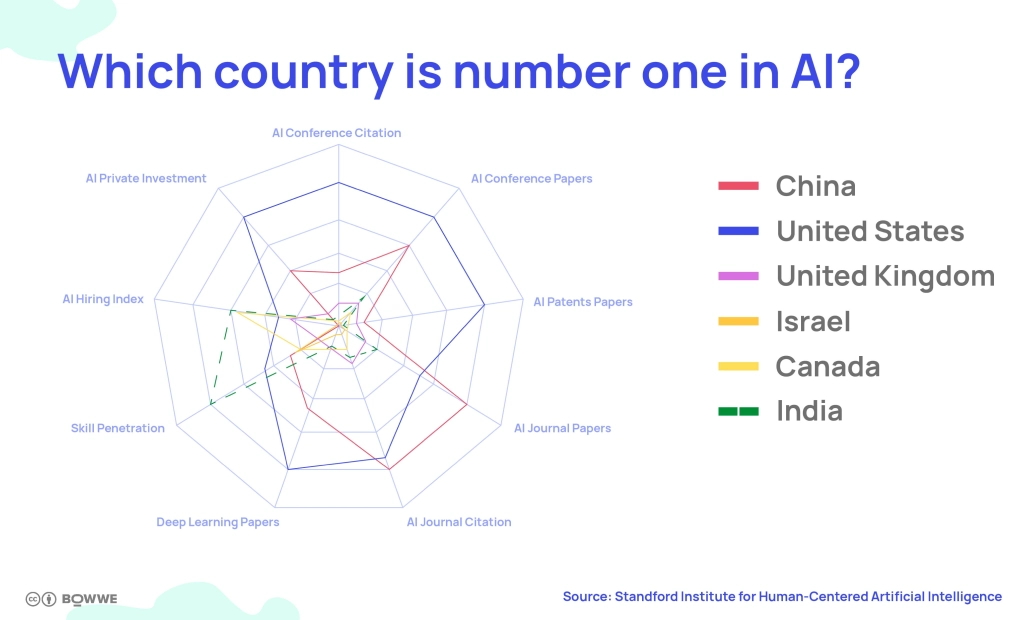
China
China has emerged as a leader in AI, with a large and growing AI research community and a number of successful AI companies. The country has also made significant investments in AI infrastructure and has implemented policies to support the development of the AI industry.
Other the countries that are pretend to be leaders in active investing in and developing AI include:
United States
The United States has a long history of leadership in AI research and development, and continues to be a major player in the field. The country is home to many of the world's leading AI research institutions and companies, and has a strong ecosystem of venture capital and startups focused on AI.
Canada
Canada has a thriving AI ecosystem and is home to a number of leading AI research institutions and companies. The country has also implemented policies to support the development of the AI industry, including the establishment of the Vector Institute for Artificial Intelligence.
Japan
Japan is a major player in AI and has a strong tradition of research and development in this field. The country is home to a number of leading AI research institutions and companies, and has made significant investments in AI infrastructure and initiatives.
Other countries that are also actively developing in the field of AI include: South Korea, India, and the United Kingdom.
Get started
No coding experience required.
Who is the leader in AI right now?
- Google has made significant investments in AI and has a number of successful AI products and initiatives, including DeepMind and TensorFlow.
- Microsoft has a strong presence in the AI market and has developed a number of successful AI products and initiatives, including Azure Machine Learning and the Microsoft AI Platform.
- IBM has a long history of leadership in AI and has developed a number of successful AI products and initiatives, including Watson and the IBM Cloud.
- Amazon has made significant investments in AI and has a number of successful AI products and initiatives, including Amazon Web Services (AWS) and the Alexa virtual assistant.
In addition to these companies, there are also many individual researchers and scientists who are considered to be leaders in the field of AI. Some examples of notable figures in the AI community include Andrew Ng, Yann LeCun, and Fei-Fei Li.
Fun facts about artificial intelligence
- In 2015, an AI system called "Eugene Goostman" was able to convince 33% of human judges that it was a 13-year-old Ukrainian boy, making it the first machine to pass the Turing Test.
- In 2017, researchers at Google developed an AI system called "DeepMind" that was able to learn how to play the game of Go at a superhuman level by analyzing thousands of previous games played by human experts.
- Also in 2017, a team of researchers at OpenAI developed an AI system called "Dactyl" that was able to teach itself to manipulate objects in a virtual environment using a robotic hand.
- In 2018, an AI system called "Pluribus" developed by Facebook and Carnegie Mellon University was able to defeat professional poker players in a multi-player game of no-limit Texas hold'em.
- In 2018, an AI system called "NORA" was developed by researchers at the University of Massachusetts to create surrealist paintings. Some of the paintings produced by NORA were described as "absurd" and "bizarre," and one critic even compared them to the works of the surrealist artist Salvador Dali.
- In 2019, an AI system called "GPT-2" developed by OpenAI was able to generate realistic-sounding human-like text when given a prompt.
- In 2020, an AI system called "Benjamin" was developed by researchers at the Massachusetts Institute of Technology to write and produce a short film called "Sunspring." The film, which was written entirely by the AI system, was described by one critic as "unwatchable."
The Future of AI - summary
Thanks for reading this article. I hope that you have found the information presented here to be interesting and informative. Now is the time to speculate and ask one last question: what will the future of AI look like?
It's an exciting question and it’s difficult to predict exactly what the future might hold. However, here are a few possible scenarios that could emerge as AI continues to advance:
- AI could become an increasingly important part of our daily lives, with intelligent systems and devices helping us to accomplish tasks and make decisions.
- AI could be used to solve some of the world's most pressing problems, such as climate change, disease, and poverty.
- AI could enable us to explore new frontiers and unlock new discoveries, from the depths of space to the mysteries of the human brain.
- AI could also pose challenges and risks, including issues related to bias, privacy, security, and employment.
Ultimately, the future of AI is likely to be shaped by the choices that we make as a society and the values that we prioritize. It will be important for us to carefully consider the implications of AI and to ensure that it is developed and used in a responsible and ethical manner. Therefore, I hope that this article has provided you with some insight into the current state of AI, its potential and will help you to form an opinion about it, whether you are an AI researcher, an entrepreneur, or simply someone who is interested in technology. Lastly, I invite you to read more blog articles, where we will cover the topics of technology and AI more than once.
Let's start!

Karol is a serial entrepreneur, e-commerce speaker m.in for the World Bank, and founder of 3 startups, as part of which he has advised several hundred companies. He was also responsible for projects of the largest financial institutions in Europe, with the smallest project being worth over €50 million.
He has two master's degrees, one in Computer Science and the other in Marketing Management, obtained during his studies in Poland and Portugal. He gained experience in Silicon Valley and while running companies in many countries, including Poland, Portugal, the United States, and Great Britain. For over ten years, he has been helping startups, financial institutions, small and medium-sized enterprises to improve their functioning through digitization.

